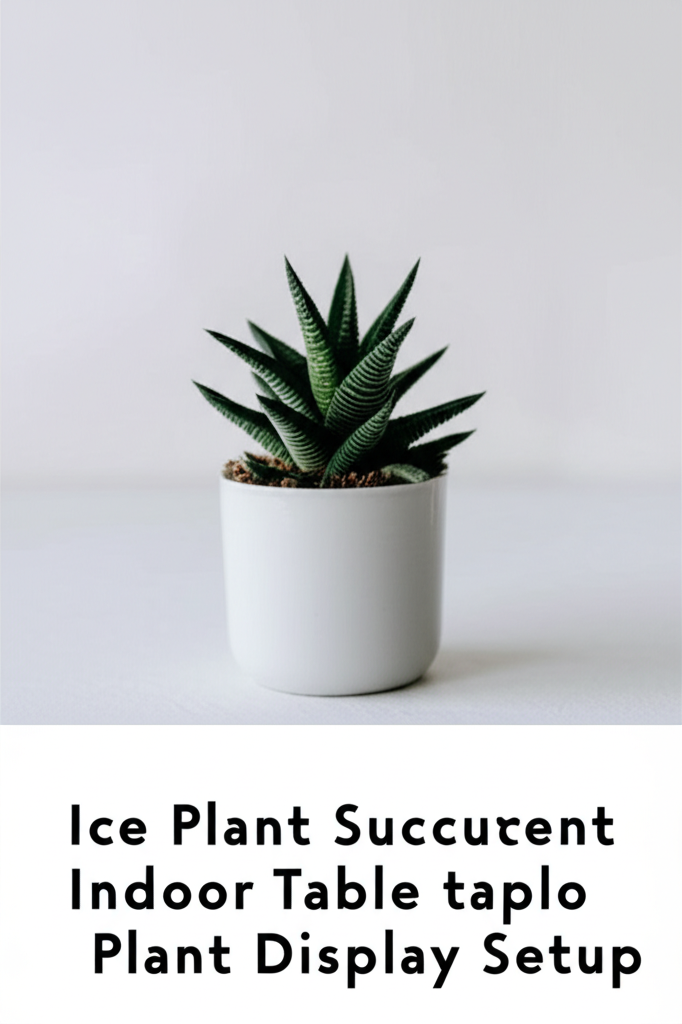The Allure of the Ice Plant Succulent for Your Tabletop
In the quest for captivating, low-maintenance indoor greenery, the ice plant succulent emerges as a stellar contender, particularly for petite tabletop displays. These remarkable plants, belonging to the Aizoaceae family, are renowned for their distinctive, jewel-like epidermal cells that glisten and refract light, often resembling tiny ice crystals. Their compact growth habit and diverse forms make them ideal candidates for creating miniature living art pieces that can brighten any desk, shelf, or windowsill. This guide will delve into the specifics of selecting, potting, and displaying ice plant succulents to create a stunning and enduring tabletop focal point.
Understanding the Ice Plant Succulent
Before
html
<h2>Ice Plant Succulent Indoor Tiny Tabletop Plant Display Setup: Key Facts/Comparison</h2>
<table>
<thead>
<tr>
<th>Feature</th>
<th>Ice Plant (e.g., Delosperma)</th>
<th>Other Tiny Tabletop Succulents (e.g., Haworthia, Echeveria 'Lola')</th>
<th>Comparison/Notes</th>
</tr>
</thead>
<tbody>
<tr>
<td><strong>Light Requirements</strong></td>
<td>Full sun to bright indirect light. Needs at least 6 hours of direct sun daily for best flowering and compact growth.</td>
<td>Bright indirect light to partial shade. Can tolerate lower light than many ice plants but may become leggy.</td>
<td>Ice plants generally require more intense light.</td>
</tr>
<tr>
<td><strong>Watering Needs</strong></td>
<td>Drought tolerant. Allow soil to dry out completely between waterings. Overwatering is a common killer.</td>
<td>Drought tolerant. Allow soil to dry out completely between waterings.</td>
<td>Both are drought tolerant. Be cautious of overwatering, especially in small containers.</td>
</tr>
<tr>
<td><strong>Soil Type</strong></td>
<td>Well-draining cactus or succulent mix. Avoid heavy, moisture-retentive soils.</td>
<td>Well-draining cactus or succulent mix.</td>
<td>Essential for preventing root rot for both.</td>
</tr>
<tr>
<td><strong>Temperature Preferences</strong></td>
<td>Prefers warm temperatures (65-75°F / 18-24°C). Can tolerate cooler temperatures but generally not frost.</td>
<td>Generally prefer warmer temperatures but many are tolerant of a wider range, including cooler indoor conditions.</td>
<td>Ice plants may require slightly warmer conditions to thrive indoors compared to some other popular tabletop succulents.</td>
</tr>
<tr>
<td><strong>Flowering Potential</strong></td>
<td>Known for prolific, daisy-like flowers in vibrant colors (pink, orange, yellow, red).</td>
<td>Some produce flowers (e.g., Haworthia spikes), but often less showy or a secondary characteristic.</td>
<td>If vibrant floral display is a priority, ice plants excel.</td>
</tr>
<tr>
<td><strong>Growth Habit</strong></td>
<td>Low-growing, spreading or trailing habit. Can be very compact for tabletop use.</td>
<td>Varies from rosette-forming (Echeveria) to upright and architectural (Haworthia).</td>
<td>Ice plants are often well-suited for cascading or mat-forming tabletop displays.</td>
</tr>
<tr>
<td><strong>Humidity Tolerance</strong></td>
<td>Low to moderate humidity. Good air circulation is important.</td>
<td>Low to moderate humidity. Good air circulation is important.</td>
<td>Both prefer drier air.</td>
</tr>
<tr>
<td><strong>Tabletop Display Suitability</strong></td>
<td>Excellent due to compact, often trailing/spreading growth and vibrant flowers.</td>
<td>Excellent due to small size and architectural forms.</td>
<td>Both are ideal for small spaces. Ice plants add a unique floral element.</td>
</tr>
</tbody>
</table>
<h2>Ice Plant Succulent Indoor Tiny Tabletop Plant Display Setup: Steps/Pros-Cons</h2>
<table>
<thead>
<tr>
<th>Category</th>
<th>Details</th>
</tr>
</thead>
<tbody>
<tr>
<td><h3>Setup Steps</h3></td>
<td>
<ol>
<li><strong>Choose a Pot:</strong> Select a small, shallow pot with drainage holes (terracotta or ceramic are good).</li>
<li><strong>Prepare Soil:</strong> Use a well-draining succulent or cactus mix, or create your own (e.g., potting soil + perlite/pumice).</li>
<li><strong>Planting:</strong> Gently remove the ice plant from its nursery pot. Place it in the new pot, ensuring the base of the plant is at the soil surface. Fill with soil, leaving about ½ inch space from the rim.</li>
<li><strong>Placement:</strong> Position the pot in a location that receives at least 6 hours of direct sunlight per day. A south-facing window is often ideal.</li>
<li><strong>Initial Watering:</strong> Water lightly after planting, or wait a day or two to allow any damaged roots to heal.</li>
<li><strong>Ongoing Care:</strong> Water thoroughly only when the soil is completely dry. Ensure good air circulation.</li>
</ol>
</td>
</tr>
<tr>
<td><h3>Pros</h3></td>
<td>
<ul>
<li><strong>Vibrant Flowers:</strong> Offers a striking floral display, adding color to small spaces.</li>
<li><strong>Drought Tolerance:</strong> Requires infrequent watering, making it low-maintenance.</li>
<li><strong>Compact Growth:</strong> Naturally stays small, perfect for tabletops and windowsills.</li>
<li><strong>Unique Texture:</strong> Fleshy leaves are visually interesting.</li>
<li><strong>Air Purification:</strong> Like most plants, can contribute to better indoor air quality.</li>
</ul>
</td>
</tr>
<tr>
<td><h3>Cons</h3></td>
<td>
<ul>
<li><strong>High Light Needs:</strong> May struggle indoors without a very bright, sunny spot. Can become leggy or stop flowering in insufficient light.</li>
<li><strong>Overwatering Risk:</strong> Extremely susceptible to root rot if overwatered.</li>
<li><strong>Frost Sensitivity:</strong> Cannot tolerate freezing temperatures.</li>
<li><strong>Pest Susceptibility:</strong> Can occasionally attract mealybugs or spider mites if stressed.</li>
<li><strong>Flowering Seasonality:</strong> While many flower profusely in summer, bloom may be less consistent indoors year-round.</li>
</ul>
</td>
</tr>
</tbody>
</table>


